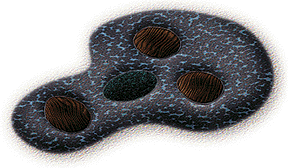

Continued
 The University of Chicago Magazine June 1996
The University of Chicago Magazine June 1996

Continued
diphtheria toxin and other proteins that create pores in cell membranes. Thompson thinks both the bclx and bcl2 proteins, which reside on the outside of the mitochondria and nucleus, are pores that allow ions like potassium to flow freely across these cellular components. Such pores, he believes, may have played an essential role in the origin of nucleated cells-the evolutionary offspring of bacteria and the first step toward multicellular life. A defect in such pores would tell the cell it is so fundamentally messed up that it must commit suicide.
Just as cancer and autoimmune disease are now viewed as disorders of increased cell survival, other catastrophic diseases are becoming seen as disorders of excess cell death-and apoptosis clearly plays a role. AIDS, for instance, decimates the ranks of CD4 T-lymphocytes, the host cells of the HIV virus. Yet most of the dying T-cells do not appear to be infected with HIV. Instead, it now seems, the virus sends a signal throughout the body that causes uninfected T-cells to apoptose. Likewise-according to data compiled by Thompson and diabetes researcher Kenneth Polonsky, professor of medicine and chief of endocrinology-at least one type of adult-onset diabetes may also be linked to a rise in apoptosis.
Perhaps the most active area of research on untimely cell death is neurodegenerative disorders like Alzheimer's, Parkinson's, Huntington's, and Lou Gehrig's diseases. These afflictions draw apoptosis researchers because programmed cell death is so obviously involved: In each case, nerve cells succumb with a suspicious lack of inflammation. Neuroscience professor Richard Miller focuses on these illnesses as well as the nervous system's quicker assailants, like epilepsy and stroke. "We know during the development of the nervous system, many more nerve cells are made than are necessary, and a lot of them die," Miller explains. "And they die by apoptosis, very clearly. So the question is, could this [same] process be turned on in pathological situations?"
Just a couple of years ago, no one knew the answer: Apoptosis researchers, Miller points out, had studied only dividing cells, whereas the nerve cells stop dividing once development is complete. "From our work and others'," he now says, "it's quite clear that neurons do undergo apoptosis, and that a lot of the proteins that people have discovered in immunology and tumor biology appear to be operative in nerve cells as well."
One such protein, Miller has just found, is made by good old p53, the well-publicized tumor-suppressor gene. Working with neurology professor Raymond Roos and Jeffrey Leiden, AB'75, PhD'79, MD'81, professor of medicine and section chief of cardiology, Miller developed a way to package the p53 gene in virus particles and get the virus into the neuron, whose hijacked cell machinery then cranks out p53 protein. "Normally, what p53 does in a tumor cell is, it stops it from dividing and then kills it," Miller says. "But nerve cells don't divide anyway-so do they have p53, and what does it do?" When his group put their p53-bearing virus into nerve cells, those cells died of apoptosis. That leads Miller to ask, "Is p53 ever induced in nerve cells in Alzheimer's disease or stroke or those other kinds of things? And the indications are that perhaps it is."
Apoptosis can't be blamed for every cell's death in neurodegenerative diseases, Miller notes: Necrosis is often its accomplice. "In most of these diseases it's probably not black or white, but both processes occurring simultaneously," he concedes. In a stroke, for instance, simple necrosis snuffs the blood-starved cells nearest the clot or hemorrhage: Only more distant cells elect apoptosis, "so you could only prevent its spread." But in neurodegenerative diseases like Alzheimer's, Miller says, "apoptosis is becoming recognized as a major player"-and hence a window for therapy.
Sometimes even necrosis can be a good thing, as in Chicago's most clinical cell-death research. A mix of apoptosis and necrosis is what Ralph Weichselbaum thinks made a recent experimental cancer treatment of his show extraordinary promise. Weichselbaum, who chairs the radiation and cellular oncology department, combined gene and radiation therapies to attack cancer cells with a therapeutic one-two punch.
His team linked the gene for tumor necrosis factor-alpha (tnf-a)-a natural substance that can kill tumor cells or make them more sensitive to radiation-with the "on-off switch" from another gene, called egr-1. By coupling the tnf-a gene with the egr-1 switch-which is flipped on by exposure to radiation-the researchers created an anti-cancer gene that can be injected into tumors, then activated by radiation therapy. In studies on radiation-resistant human tumors transplanted into mice, Weichselbaum and his coworkers found the combined therapy to be far more effective than radiation or gene therapy alone.
"In our system, necrosis is the predominant death, not apoptosis," Weichselbaum says. While he can't fully explain the two therapies' synergy, he thinks that the treatment works by causing apoptosis in the blood vessels that feed the tumor. In turn, the loss of nourishment causes death by necrosis in the tumor itself.
Weichselbaum was glad to see what he calls "good, old-fashioned necrosis"-it's a dirty but very sure death. Conventional radiation therapy, he explains, appears to kill tumors mostly through the "petals from a flower" method of apoptosis. Thus evidence of necrosis, with its meat-axe approach, suggests that his new therapy may provide a weapon against radioresistant cells like brain tumors.
For killing renegade cancer cells, necrosis may still have its place, but the excitement about cell death sharply focuses on apoptosis. In the last four years, 4,300 research papers on it have been published, the output nearly doubling each year. And just a couple of months ago, a team of plant biologists from the University of California, Davis, stumbled upon apoptosis in tomatoes, opening a whole new kingdom of life to the study of death.
Return to opening of "Death by design"
Go to:
Return to June 1996 Table of Contents